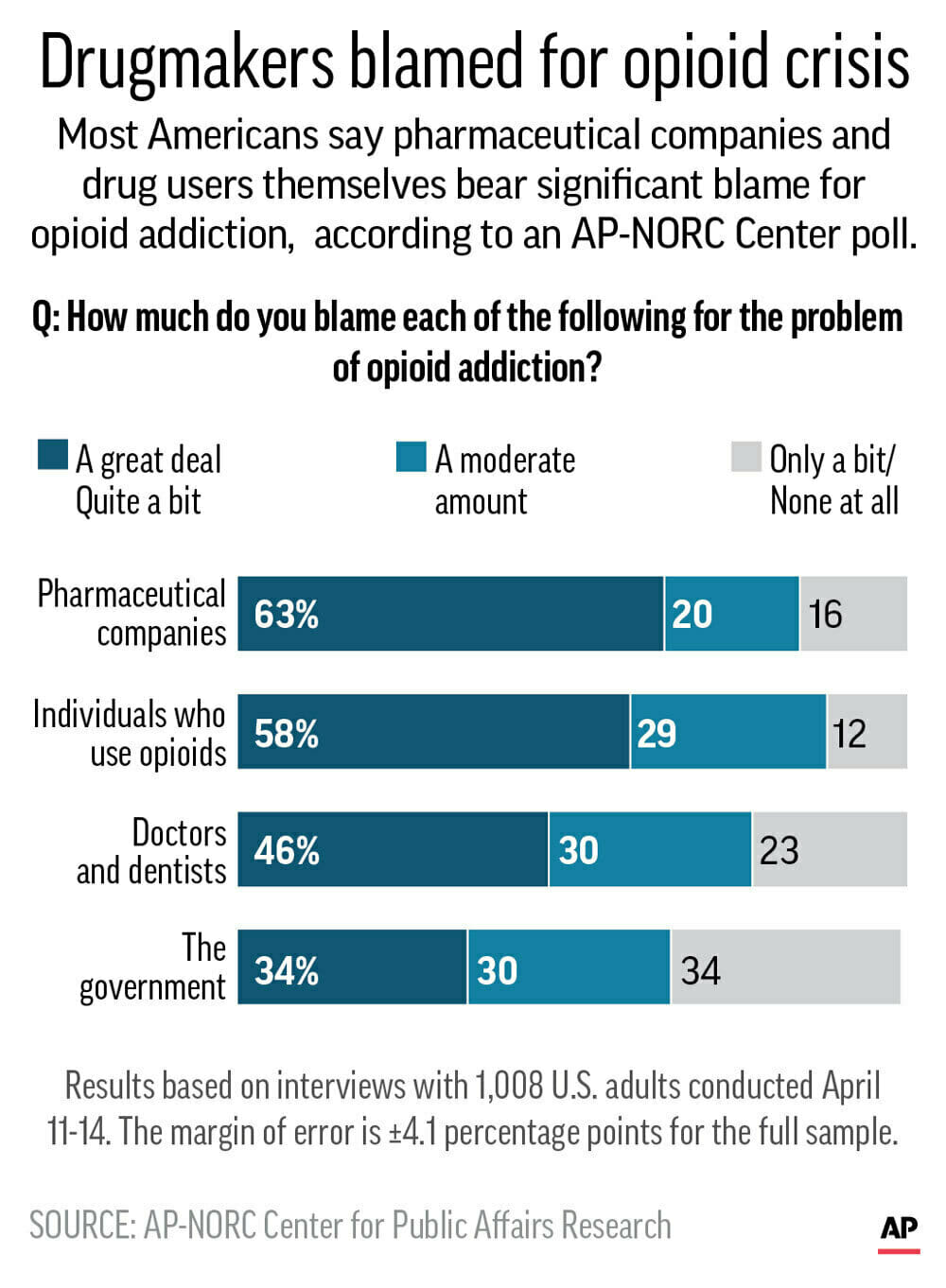
AP-NORC Poll: Many blame drug firms for opioid crisis
NEW YORK (AP) — About two-thirds of Americans believe drug companies are to blame for the opioid crisis, although nearly as many hold drug users themselves responsible, a new poll finds.
The Associated Press-NORC Center for Public Affairs Research poll showed many people also fault doctors who prescribed opioid pain pills and government officials who haven’t done enough to expand addiction treatment and arrest drug dealers.
“All of the above,” said Anna Marie Davis, a casino security supervisor from Norwood, Pennsylvania. She said she has had to deal with overdoses at work and that her 27-year-old nephew, who used heroin and fentanyl, died of a drug overdose last year.
“It’s pretty bad,” she said of the drug overdose problem. “I honestly don’t think they’re doing enough” to stop it, she added.
The United States is in the midst of the deadliest drug overdose crisis in the nation’s history. More than 70,000 people died from drug overdoses in 2017. Nearly 48,000 involved some type of opioid, a category that includes heroin, fentanyl and prescription opioid painkillers.
Experts say the overdose epidemic is rooted in a boom in opioid painkiller prescriptions that began more than 20 years ago, which they say fostered addictions that later shifted into use of heroin and other drugs.
The AP-NORC poll was conducted this month amid a legal storm: About 2,000 lawsuits have been filed in the past few years seeking to hold the drug industry responsible for the nation’s drug overdose crisis.
Some of the people participating in the poll said they were following the news and felt manufacturers should be held accountable.
But many also expressed strong feelings that people taking drugs are to blame. Among them was Pamela Williams of New York City, who said she was addicted to cocaine and other drugs until she stopped about 25 years ago.
“Nobody’s forcing them to take drugs. Nobody puts it in their hand and puts a gun to the head and says; ‘Here, take this,” said Williams, who lives in the Bronx.
Dr. Daniel Ciccarone, a drug policy expert at the University of California at San Francisco, noted that the survey doesn’t explain why people are turning to drugs and alcohol. He said people seem to be “self-medicating” as they struggle with depression, lack of money or other issues.
Carmen Amato, a 52-year-old retired teacher from Frankfort, Kentucky, echoed that.
“People can’t make a living in some parts of our state and don’t seem to have any other prospects besides use drugs,” Amato said. “It’s terrible.”
According to the poll, 63% of Americans think pharmaceutical companies are quite a bit or a great deal to blame for the problem of opioid addiction, while 58% say the same about people abusing opioids. Slightly less than half — 46% — think doctors and dentists are significantly to blame, and about a third — 34% — say that about the government.
The poll shows 35% say they or someone close to them has been addicted to prescription painkillers or heroin.
White Americans were more likely than black Americans to say they’ve known someone who was addicted, 39% to 20%. Americans under 30 were more likely than older people to say they’ve known someone who was addicted, 44% to 32%.
People who have personally been close to someone addicted to opioids were more likely than others to blame pharmaceutical companies, 70% to 59%. They were also somewhat more likely to blame doctors and dentists (52% to 43 and the government (41% to 31%), but not significantly more or less likely to blame opioid users themselves.
The poll also detected a partisan divide.
Democrats are more likely than Republicans to blame pharmaceutical companies (72% to 53 and the government (42% to 26%). Republicans were more likely than Democrats to blame users (69% to 51%).
___
The AP-NORC poll of 1,108 adults was conducted April 11-14 using a sample drawn from NORC’s probability-based AmeriSpeak Panel, which is designed to be representative of the U.S. population. The margin of sampling error for all respondents is plus or minus 4.1 percentage points. Respondents were first selected randomly using address-based sampling methods, and later interviewed online or by phone.
___
Swanson reported from Washington.
___
Online:
AP-NORC Center: http://www.apnorc.org/
The Western Journal has not reviewed this Associated Press story prior to publication. Therefore, it may contain editorial bias or may in some other way not meet our normal editorial standards. It is provided to our readers as a service from The Western Journal.
Truth and Accuracy
We are committed to truth and accuracy in all of our journalism. Read our editorial standards.
Advertise with The Western Journal and reach millions of highly engaged readers, while supporting our work. Advertise Today.












